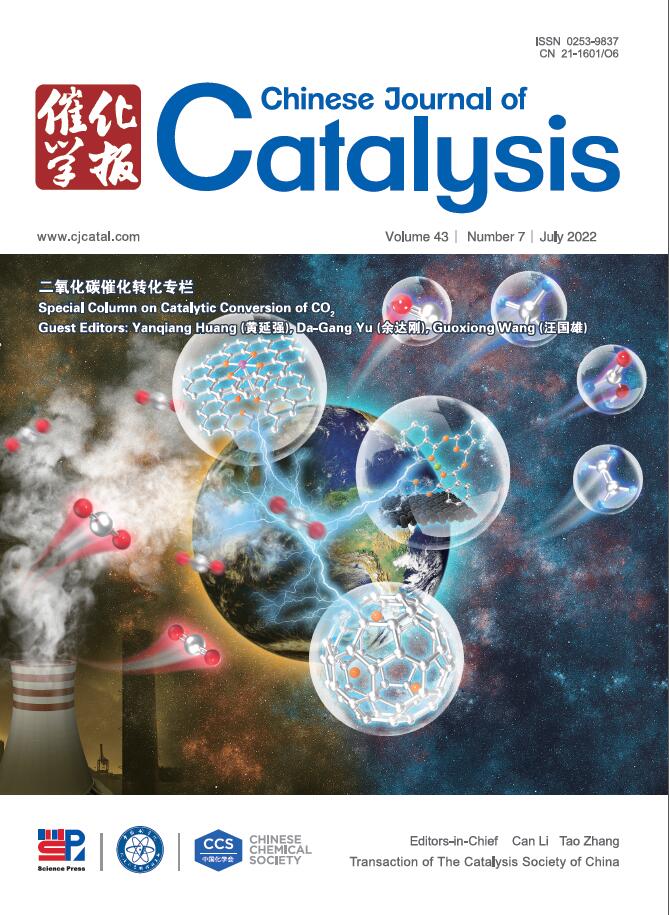Understanding the reaction-induced restructuring of CoOx species in silicalite-1 to control selectivity in non-oxidative dehydrogenation of propane
IF 17.7
1区 化学
Q1 CHEMISTRY, APPLIED
引用次数: 0
Abstract
Non-oxidative dehydrogenation of propane (PDH) is an important route for large-scale on purpose propene production. Although cobalt-based catalysts are promising alternatives to currently used platinum- or chromium oxide-based catalysts, their further developments are hindered by the uncertainties related to the kind of the active sites involved in the desired and side reactions. To contribute to closing such a gap, we systematically investigate the role of oxidized CoOx and metallic Co0 species in the PDH reaction over catalysts based in Silicalite-1 with supported CoOx species differing in their redox properties. C3H8 pulse experiments with sub-millisecond and second resolution at pulse sizes of about 13 and 2200 nmol, respectively, combined with in-depth catalyst characterization and PDH tests at different propane conversions enabled us to understand how the reaction-induced reduction of CoOx affects product selectivity. Propane readily reacts with CoOx to yield propene, carbon oxides and water. The formed Co0 species show high activity to coking and cracking reactions. However, if the size of such species is below 2 nm, these undesired reactions are significantly hindered due to the coverage of the active sites by carbon-containing species. The remaining uncovered surface Co0 sites selectively dehydrogenate propane to propene. The best-performing catalyst showed higher activity than a commercial-like K-CrOx/Al2O3 and operated durable in a series of 10 dehydrogenation/regeneration cycles under industrial relevant conditions. The space time yield of propene formation of 0.97 kg·h–1·kgcat–1 was achieved at 550 °C, 52% equilibrium propane conversion and 95% propene selectivity.
了解反应诱导的硅石-1中CoOx物种的重组以控制丙烷非氧化脱氢的选择性
丙烷非氧化脱氢是大规模定向生产丙烯的重要途径。虽然钴基催化剂是目前使用的铂基或氧化铬基催化剂的有希望的替代品,但它们的进一步发展受到与期望反应和副反应所涉及的活性位点类型相关的不确定性的阻碍。为了缩小这一差距,我们系统地研究了氧化CoOx和金属coo0在PDH反应中的作用,这些反应是基于硅石-1的催化剂,支持CoOx的氧化还原性质不同。通过脉冲尺寸分别为13和2200 nmol的亚毫秒和秒分辨率的C3H8脉冲实验,结合深入的催化剂表征和不同丙烷转化率的PDH测试,我们了解了反应诱导CoOx还原对产物选择性的影响。丙烷很容易与CoOx反应生成丙烯、碳氧化物和水。生成的Co0组分对焦化和裂解反应表现出较高的活性。然而,如果这类物质的尺寸小于2nm,由于含碳物质覆盖了活性位点,这些不希望发生的反应就会受到严重阻碍。剩余未覆盖的表面Co0位点选择性地使丙烷脱氢生成丙烯。性能最好的催化剂表现出比商用K-CrOx/Al2O3催化剂更高的活性,并且在工业相关条件下连续10次脱氢/再生循环中运行持久。在550℃条件下,丙烯的时空产率为0.97 kg·h-1·kgcat-1,丙烷平衡转化率为52%,丙烯选择性为95%。
本文章由计算机程序翻译,如有差异,请以英文原文为准。
求助全文
约1分钟内获得全文
求助全文
来源期刊

Chinese Journal of Catalysis
工程技术-工程:化工
CiteScore
25.80
自引率
10.30%
发文量
235
审稿时长
1.2 months
期刊介绍:
The journal covers a broad scope, encompassing new trends in catalysis for applications in energy production, environmental protection, and the preparation of materials, petroleum chemicals, and fine chemicals. It explores the scientific foundation for preparing and activating catalysts of commercial interest, emphasizing representative models.The focus includes spectroscopic methods for structural characterization, especially in situ techniques, as well as new theoretical methods with practical impact in catalysis and catalytic reactions.The journal delves into the relationship between homogeneous and heterogeneous catalysis and includes theoretical studies on the structure and reactivity of catalysts.Additionally, contributions on photocatalysis, biocatalysis, surface science, and catalysis-related chemical kinetics are welcomed.
 求助内容:
求助内容: 应助结果提醒方式:
应助结果提醒方式:


